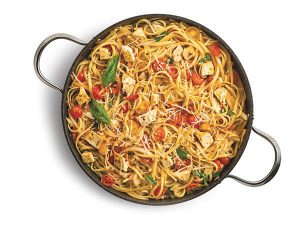November 11, 2020
Debunked by the Dietitian: Common Cooking Myths Solved!
 By Katie Schaeffer, RD, LD
By Katie Schaeffer, RD, LD
Hy-Vee Registered Dietician
(563) 359-9323 KSchaeffer@hy-vee.com
Do you ever feel intimidated to get in the kitchen all because of “cooking rules” you have heard of? Some of the most common cooking claims you may have run across in your lifetime simply are not true. Your Hy-Vee dietitians want you to succeed in all your cooking adventures and not be discouraged in preparing and eating the food you love. We get a lot of questions about food, cooking and nutrition and we are sharing and debunking the top 10 myths most asked about
in 2020.
1. MYTH: Cooking vegetables removes nutrients.
Truth: Only with boiling. The trick to retaining most nutrients, especially vitamin C and B vitamins, is to use as little water as possible and cook for a minimal amount of time. Steaming and microwaving, as well as dry-heat methods like grilling, roasting, and stir-frying, retain the most nutrients.
2. MYTH: Salting pasta or potato water makes it boil faster.
Truth: Adding salt makes the water hotter but it’s not going to boil any faster. The reason to add salt is to season the food, not speed up the clock.
3. MYTH: Rinse meat before cooking.
Truth: Recent USDA research has found that rinsing raw meat or poultry increases the risk for spreading bacteria to your sink, hands, and cooking equipment, which can cause foodborne illness.
4. Myth: Using high heat cooks grains faster.
Truth: High heat won’t actually speed the cooking of rice and quinoa. The water needs to simmer so it can permeate the grains. High heat also causes water to quickly evaporate, which would result in an undercooked grain that may burn.
5. Myth: Fresh eggs peel more easily when hard-boiled.
Truth: To ensure easily peeled hard-boiled eggs, the American Egg Board suggests that you buy and refrigerate them a week to 10 days before cooking. This brief “breather” allows the eggs time to take in air, which leads to membranes separating from the shell.
6. MYTH: Chicken is safe to eat when it’s no longer pink.
Truth: It’s only safe when cooked to an internal temperature of 165°F., as recommended by the USDA for food safety. Whether you cook a whole bird or chicken parts, color can change from pink to white at a lower temperature, so it’s best to test with a food thermometer.
7. Myth: Alcohol burns off when cooked.
Truth: Cooking will result in some, but not total, loss of alcohol. A study from the U.S. Department of Agriculture Nutrient Data Lab reveals that the amount of alcohol that remains in food after cooking is directly related to the temperature at which the food is cooked and the amount of time cooked. If you simmer a wine-reduction sauce for 15 minutes, it retains 40 percent alcohol. Even after an hour, 25 percent of the alcohol remains. A pot roast made with 1 cup of burgundy and roasted for more than 2 hours, however, retains only 5 percent alcohol.
8. Myth: Chile pepper seeds contain heat.
Truth: A chile pepper’s spicy heat comes from the white membrane — also referred to as the pith or ribs — of the pepper, not the seeds. The seeds contain little to no capsaicin, which gives peppers their intensity. When the membrane is cut, the capsaicin escapes and adheres to the outside of seeds, making them seem spicy.
9. MYTH: Well-done meat is safer to eat.
Truth: Eating steak that’s pink is safe if it’s cooked to medium-rare (130°F). Because E. coli bacteria primarily live on the surface of the meat, it’s easy to destroy by cooking. When meat is ground or mechanically tenderized, E. coli can be transferred to the inside of the meat, in which case it must be cooked to 165°F (well done).
10. MYTH: It’s always best to add oil to pasta water.
Truth: Some of the best Italian chefs don’t advise it. Although oil helps keep the water from boiling over, it prevents any sauce from sticking to the pasta.
One-Pot Chicken Pasta

Serves 6
All you need:
- 4 cups water
- Hy-Vee kosher sea salt, to taste
- Hy-Vee ground black pepper, to taste
- ½ tsp Hy-Vee red pepper flakes
- 2 tbsp Hy-Vee Select extra-virgin olive oil, plus more for serving
- 12 oz. Hy-Vee linguine pasta
- 1½ cups cherry tomatoes
- 1 large white onion, thinly sliced
- 4 cloves garlic, thinly sliced
- 3 sprigs fresh basil, plus roughly chopped basil for garnish
- 16 oz. cooked chicken breast, sliced or cubed
- Freshly grated Parmesan cheese, for serving
All you do:
- Add the water, salt, pepper, red pepper flakes, and olive oil to a large skillet and stir over high heat. Once boiling, add pasta, tomatoes, onion, garlic and basil to the skillet and stir.
- Bring to a boil, stirring occasionally with tongs until the pasta is al dente, or firm to the bite, about 9 to 10 minutes.
- Drain water from the skillet with a mesh strainer. Season with additional salt, pepper and olive oil, to taste. Stir, and top with chicken breast. Garnish with Parmesan cheese and additional chopped basil leaves, if desired. Serve immediately.
Nutrition Facts per serving: 350 calories, 8g fat, 1g saturated fat, 0g trans fat, 55mg cholesterol, 40mg sodium, 47g carbohydrates, 3g fiber, 4g sugar, 25g protein.
Recipe source: https://www.hy-vee.com/recipes-ideas/recipes/one-pot-chicken-pasta
The information is not intended as medical advice. Please consult a medical professional for individual advice.
Filed Under: Community, Featured, Health & Wellness, News
Trackback URL: https://www.50pluslife.com/2020/11/11/debunked-by-the-dietitian-common-cooking-myths-solved/trackback/


